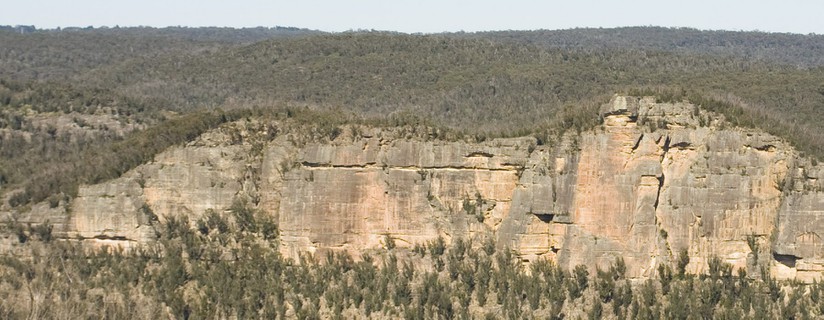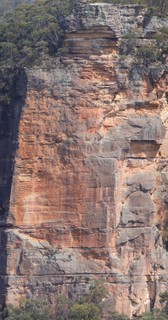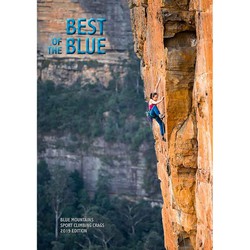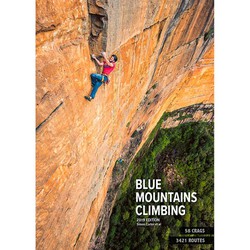

/51/19/51197174b51fe7157c68faa9abfaeb561623ca01)
description
Line of FH with DUB's starting at base of wall far Right (looking in). Rap down as for Baileys then walk north on foot ledge for 15 meters to large flake at end of ledge. If needing to walk out walk North up the valley along base, ignore first 'possible' ramp and continue until spur meets you then hike up left , poke about with a few very short easy scrambles and walk up side of hill back to top lookout. Walking south toward old shale mine track is dangerous, difficult and not recomended.
42m (23) The highlight. Up wall, step right into corner and fingery gaston crux to steep jugs. Up balancey and airy arette to triple ubolt hanging belay (bring a comfy harness?!). A small etrier or long sling to step into may give leader some kidney relief whilst belaying. Bring 20 quickdraws.
26m (24) Immediately technical and oozey getting established in fused corner/slab then exponentially steeper and difficult right to the last moves. Double U bolt belay.
26m (24) Up face, carefully through some choss to steep over hanging red wall trending left (crux) and work arete. De-pump on some good holds before final mantle. DUB Anchors set back beneath pitch 4. Set yourself up to belay back on edge for visual support as it is the hardest steepest and most exposed pitch.
16m (15) Vertical hiking up dirty corner avoiding wall under lookout for anchor discretion. Step right near top and belay from tree backed up with single U bolt.
Route history
| 26 Jan 2015 | Route setter: E .Wells |
|---|---|
| 28 Mar 2015 | First free ascent: Evan Wells & Jessica Tam |
Warnings
Location
- Lat/Lon: -33.55083, 150.29818
Some content has been provided under license from: © Australian Climbing Association Queensland (Creative Commons, Attribution, Share-Alike 2.5 AU)
Grade citation
| 24 | Assigned grade |
| 24 | private |
ethic
Although sport climbing is well entrenched as the most popular form of Blueys climbing, mixed-climbing on gear and bolts has generally been the rule over the long term. Please try to use available natural gear where possible, and do not bolt cracks or potential trad climbs. If you do the bolts may be removed.
Because of the softness of Blue Mountains sandstone, bolting should only be done by those with a solid knowledge of glue-in equipping. A recent fatality serves as a reminder that this is not an area to experiment with bolting.
If you do need to top rope, please do it through your own gear as the wear on the anchors is both difficult and expensive to maintain.
At many Blue Mountains crags, the somewhat close spacing of routes and prolific horizontal featuring means that it is easy to envisage literally hundreds of trivial linkups. By all means climb these to your hearts content but, unless it is an exceptional case due to some significant objective merit, please generally refrain from writing up linkups. A proliferation of descriptions of trivial linkups would only clutter up the guide and add confusion and will generally not add value to your fellow climbers. (If you still can't resist, consider adding a brief note to the parent route description, rather than cluttering up the guide with a whole new route entry).
If you have benefited from climbing infrastructure in NSW, please consider making a donation towards maintenance costs. The Sydney Rockclimbing Club Rebolting Fund finances the replacement of old bolts on existing climbs and the maintenance of other hardware such as fixed ropes and anchors. The SRC purchases hardware, such as bolts and glue, and distributes them to volunteer rebolters across the state of New South Wales. For more information, including donation details, visit https://sydneyrockies.org.au/rebolting/
It would be appreciated if brushing of holds and minimisation/removal of tick marks becomes part of your climbing routine. Consider bringing a water squirt bottle and mop-up rag to better remove chalk. Only use soft (hair/nylon) bristled brushes, never steel brushes.
The removal of vegetation - both from the cliff bases and the climbs - is not seen as beneficial to aesthetics of the environment nor to our access to it.
Remember, to maintain access our best approach is to 'Respect Native Habitat, Tread Softly and Leave No Trace'. Do not cut flora and keep any tracks and infrastructure as minimal as possible or risk possible closures.
For the latest access related information, or to report something of concern, visit the Australian Climbing Association NSW Blue Mountains page at https://acansw.org.au/blue-mountains/
Seasonality
Quality
Overall quality 75 from 4 ratings.
Tick Types
Comment keywords
Selected Guidebooks more Hide
Author(s): Simon Carter
Date: 2019
ISBN: 9780958079075
Simon Carter's "Best of the Blue" is the latest selected climbing guide book for the Blue Mountains and covers 1000 routes and 19 different climbing areas. For all the sport climbers out there, the travellers, or just anyone who doesn't want to lug around the big guide that's more than 3 times the size - cut out the riff-raff and get to the good stuff! This will pretty much cover everything you need!
Author(s): Simon Carter
Date: 2019
ISBN: 9780958079082
The latest comprehensive, latest and greatest Blue Mountains Climbing Guide is here and it has more routes than you can poke a clip stick at! 3421 to be exact. You are not going to get bored.
Accommodations nearby more Hide
Share this
Get a detailed insight with a timeline showing
- Ticks by climbers like you
- Discussions of the community
- Updates to the index by our users
- and many more things.
Login to see the timeline!


